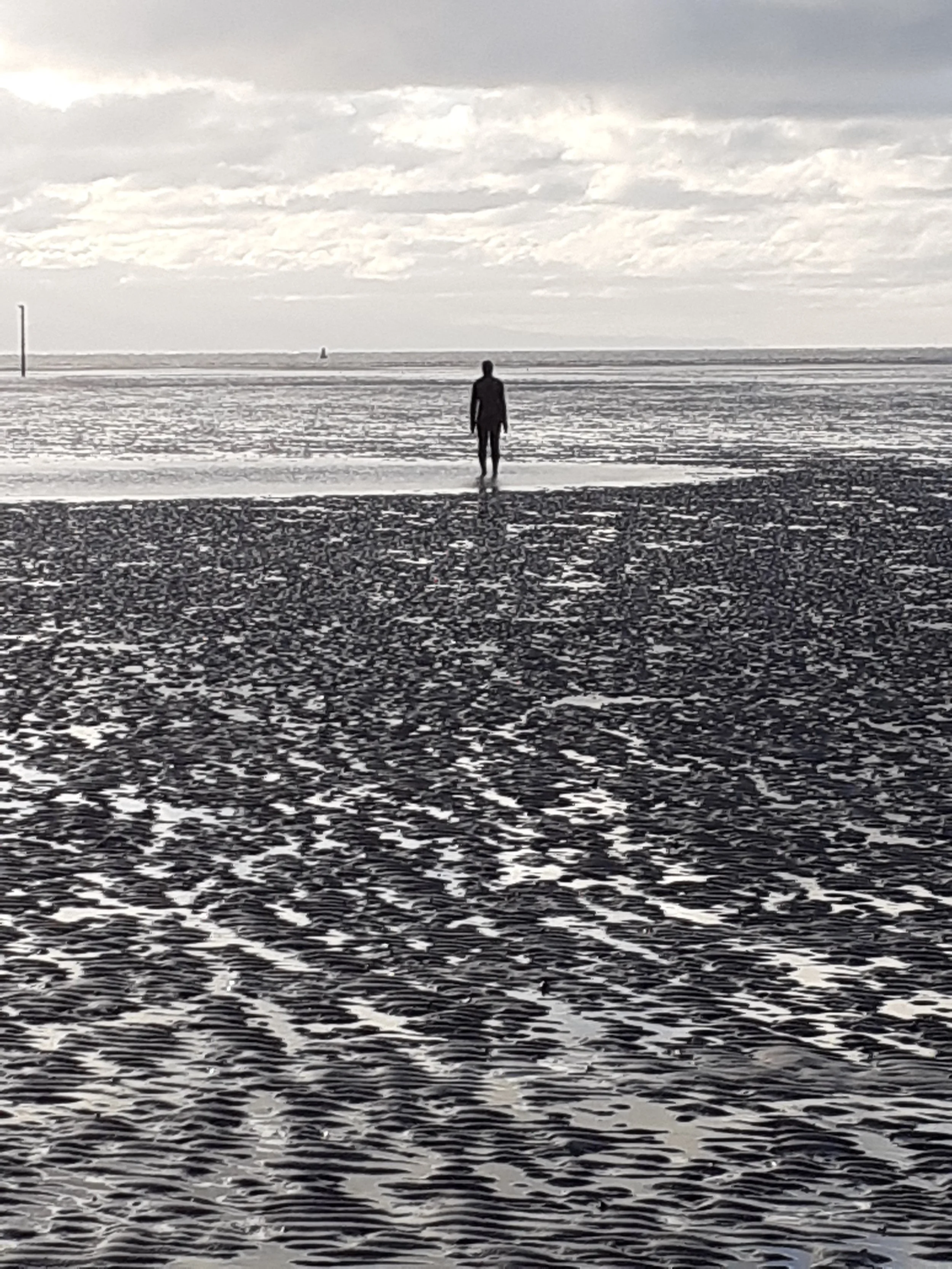Another Place / Another Time
/By Julia Bennett
This short essay is a reflection on visits to Antony Gormley art installations in the North West and South East of England. Although they have been there for a quarter of a century or less, they symbolise England’s centuries long relationship with the sea and the rest of the world beyond, and our ambiguous relationship with those who arrive on these shores. Who belongs and who is trespassing? Another Place and Another Time are installations by Anthony Gormley made from a cast of his own body.
Crosby, Merseyside.
A sunny winter’s day on the English coast, just north of Liverpool. The wide, sandy beach and coastal path are busy with family groups taking advantage of the good weather. Amongst the chattering, warmly-dressed family clusters, a silent iron man clad in a red Liverpool football shirt is standing up to his knees in sand, looking out to sea. In mid-afternoon the low December sun glints off the wet sand left by the retreating tide. Iron men are cast as shadowy figures gradually emerging from the receding sea: an (un)welcoming party of a hundred little green-red men stand, spread across the broad, flat shore. Mute. Immobile. Eyes fixed on the horizon. They seem, nevertheless, somehow aware of the dashing dogs and running children and traipsing adults, across the wide-open expanse of sea-rippled sand at low tide. Patiently they wait for the pull of the moon to draw the sea back onto their shore. Salt water swirling over feet, calves, thighs and some of them are drowned. Twice a day, every day, day-in, day-out. Waiting, as the moon shifts in the sky. Until the tide recedes, air flows once more around noses and mouths. Dark green weed sticks like hair to chests and is washed away again. Eyes stare still out over the busy sea. A ferry heads for the horizon. To the Isle of Man, just out of sight, or to Belfast, linking the disparate islands of this kingdom. Passport-free passengers oblivious to the green-red iron men, watchful on the edge of the shore. Container ships sail past, bringing Liverpool football shirts from Georgia, iron ore from Canada, Brazil, Sweden, plastic buckets and spades from China. The port’s cranes are silhouetted against the southern sky. Two hundred and fifty years ago wind-powered ships sailed south from here to Africa to trade salt and fine Indian cotton cloth for a cargo of people, no passports required. Forced onto boats, exiled and enslaved, they crossed the expanse of Atlantic Ocean. Trade winds brought back raw cotton, coffee, sugar, with which to build a city. Another place where Princes and Earls, Generals and Knights, Slavers and Capitalists, still stand on solid stone plinths in Georgian squares. They are recognised for carrying the power of wealth to these shores, colonising terra nullius, not trespassing on others’ land. Now towering turbines far out at sea bring wind power into the city. The unnamed iron men stand and watch. Their shifting foundations buffeted by the tide. Moving sands creep up their legs, threatening, snake like, to swallow them whole.
Folkestone, Kent.
A week of late-summer sunshine and calm seas. Another rusted iron man stands on a weed-green carpet under the harbour arm in Folkestone, staring out over the water to the white cliffs marking the southern edge of England. On a clear day the coast of France can be seen from the cliffs. On the beach, recent arrivals to this land barbecue meat flavoured with spices first brought here along the Silk Road, and venture into the sea, secure and safe in the shallows. Container ships and ferries traverse the blue horizon. This is the busiest shipping lane in the world. Below the squawks of gulls and chatter of tourists is the regular percussive sound of shingle crashing on shingle as waves tumble the small stones that make up the beach along this coast. Crunching and pulling the white-orange-brown stones from under feet, shifting the land along this shore where in Another Time cargoes of the unwanted reached land. In the museum a large painting shows local dignitaries welcoming Belgian refugees in 1914. Now the (un)welcoming parties greet newcomers with lifeboats and foil blankets, or empty-beer-can-missiles and racist slurs. On the chalk cliffs mapping the route, watchful patrols with binoculars and telescopes are ready to sound the alarm, when small craft are spotted bobbing in the waves like paper boats on a wind-rippled pond in the park. The drownings are offshore, at sea, mostly hidden from sight. Not daily, but far too frequent. As the moon shifts in the sky, waiting until the power of the wind calms, across the grey-blue sea under a blue-grey sky; small, fragile boats follow the tides to the relative safety of this shore. On a clear day the French coast seems so close, at arm’s length, une manche.
The green-red iron people standing on the shores of England began as nameless clones from the same mould, they are now changed and scarred by place and time. Like the dog-walkers and tourists, the rescuers and missile-throwers, the survivors and the drowned: they are us.
Julia Bennett is a sociologist and writer of non-fiction and short sociological fiction on the theme of place. She has had short stories published in The Sociological Review fiction series and So-Fi Zine. Further work can be found on her Academia page.


